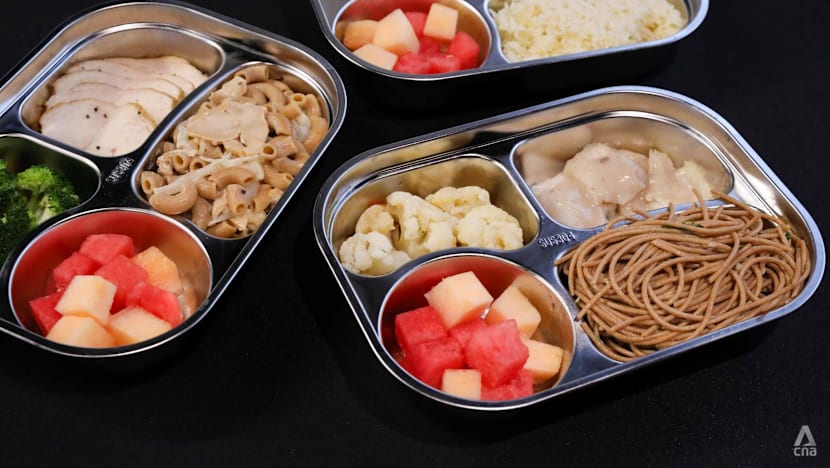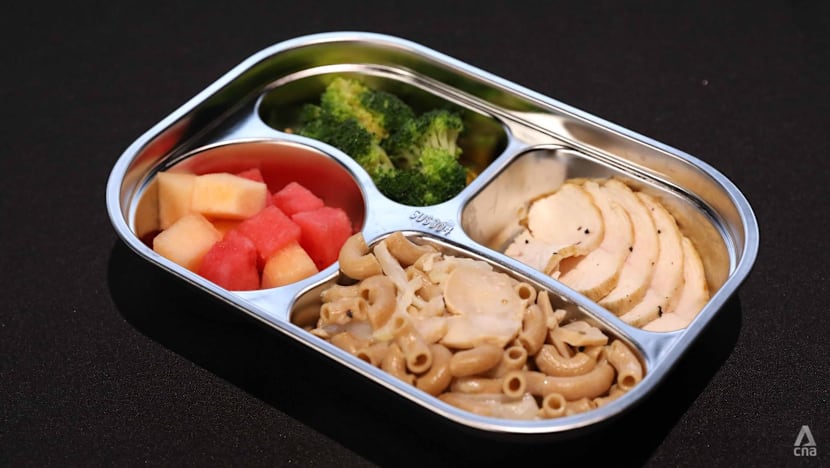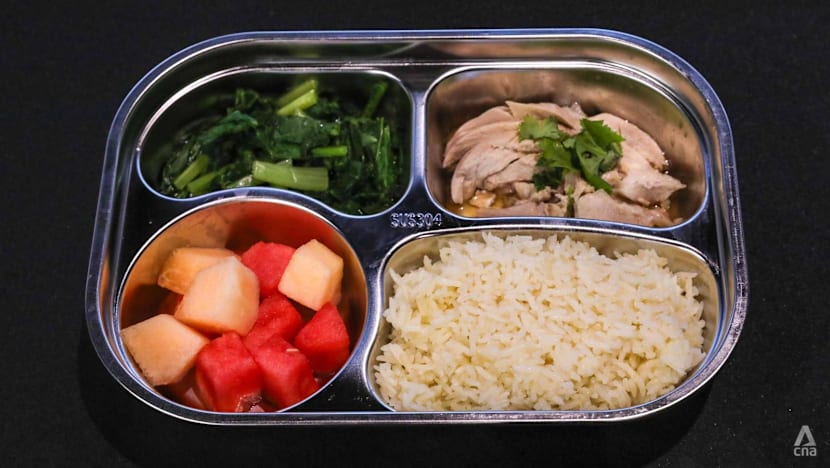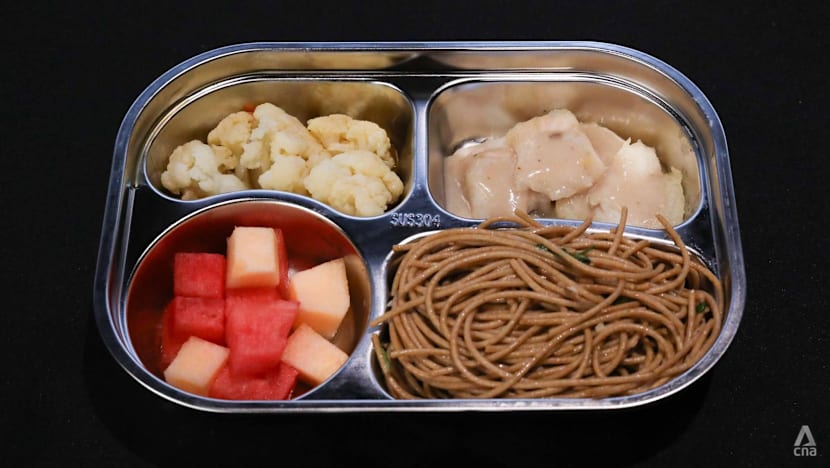Recess is served: Here's what students at 5 schools will get when they switch to pre-ordered meals
In January next year, 13 schools will switch to central kitchen catering. CNA takes a look at what students at five of them can expect when the recess bell rings.

A sample of meals from caterer Gourmetz that will be served in five out of 13 schools switching to a central kitchen model next January. (Photo: CNA/Lim Li Ting)

This audio is generated by an AI tool.
SINGAPORE: What does it take to prepare meals that appeal to primary school students? According to a caterer managing several school canteens from January next year, even the colour of vegetables matters.
“We think about what type of vegetables to use. Actually, a lot of kids don’t have fancy tastes, in fact, familiarity is comfort,” said Mr Desmond Chin, managing director of caterer Gourmetz.
“So we tend to go towards broccoli, cauliflower, green leafy vegetables like spinach, that’s about it. We wouldn’t give them fancy things like asparagus.”
From January next year, 13 schools across Singapore will roll out a central kitchen model at their canteens. The initiative builds on a 2022 pilot at Yusof Ishak Secondary School, which is managed by caterer SATS.
Gourmetz will operate five of the 13 school canteens adopting this new model – Blangah Rise Primary, CHIJ Kellock, Radin Mas Primary, River Valley Primary and Outram Secondary at its York Hill campus until it closes in 2027.
Chang Cheng Mee Wah will run canteens in Dazhong Primary, Kranji Primary, Pioneer Primary, Qifa Primary and West View Primary, while Wilmar Distribution will run the ones at Casuarina Primary, Chongzheng Primary, Northoaks Primary and Outram Secondary’s new Anchorvale Crescent campus.
The Ministry of Education (MOE) said that while most schools currently have enough canteen stalls, some are finding it increasingly difficult to attract stallholders to fill vacant ones, even with low rentals.
“Schools also face competition for stallholders from food courts, hawker centres and other public eating houses, which serve a greater customer base,” it said.
The Yusof Ishak pilot had "favourable" outcomes, MOE said, adding that the 13 schools chose to adopt the central kitchen model as stallholders retired and vacant stalls remained unfilled.
Existing stallholders may be referred to other schools or recommended to central kitchen operators for employment.
While the central kitchen model ensures access to healthy and affordable meals, the traditional model with individual stallholders remains the default for most schools.
MENU ON ROTATION
At Gourmetz-run canteens, meals will be planned in five-week blocks. Students can expect five to seven daily meal options – including vegetarian, international, local, Western and chicken rice.
Some schools will still have stalls selling noodles, snacks and drinks.
CNA sampled three meals that will be available to students: chicken rice, mushroom macaroni with grilled chicken breast and broccoli, and aglio olio spaghetti with mushroom sauce, pan-fried fish and cauliflower.



Chicken rice will be a daily staple. “There are some kids, due to the environment or preference they only eat chicken rice,” said Mr Chin, citing a survey of children from both mainstream and international schools.
The chicken rice was fragrant and tastier than expected, and the chicken was boneless and skinless – in line with Health Promotion Board (HPB) guidelines. Wholegrain versions of macaroni and spaghetti are used, and meals will be served in reusable trays with sections for carbohydrates, proteins and 50g of vegetables.
Each meal will cost between S$2.20 and S$3 depending on portion size. Gourmetz also plans to offer free fruit at a separate counter.
Gourmetz currently caters to preschools, international schools and eldercare centres. Mr Chin said one challenge is making food appealing to children, especially when introducing healthier grains and vegetables.
“There may be some complaints from parents or maybe from kids at the start that it’s too healthy," said Mr Chin. "We can adjust the menu such that the kids will still enjoy it.”
For example, wholegrain noodles may have a sour aftertaste and mixed grain rice can be harder than white rice, which may take some getting used to, he added.
Urging parents and teachers to help with the transition, he said: “There will be complaints. So if they say the veggies are too much, or so on, they will need to do their part to encourage them (to eat it).”
SHORTER WAIT TIMES
Like current canteen stalls, central kitchen operators must comply with HPB guidelines. Meals must include wholegrains, 50g of vegetables and 50g of protein. Deep frying is not allowed.
After moving to Punggol in 2022, Yusof Ishak Secondary implemented a hybrid model, combining SATS’ central kitchen bento meals with additional food options. These include three stalls offering snacks, noodle soup and fresh fruit, as well as vending machines for drinks, snacks and hot sandwiches.
Principal Chen Ziyang told CNA that the model has “significantly reduced” wait times compared to traditional canteen queues, and that students and parents have noticed the improvement.
Staff and students must place their orders via an online platform at least two days in advance. The daily menu has seven full meals, two light meals and two snacks. About 90 options are available each term, including local dishes such as nasi lemak.
At schools served by Gourmetz, students can choose their meals as early as three months or as late as one day in advance. Changes can be made up to a day before collection.
On the day, students tap their EZ-Link cards at machines or food lockers, which dispense the meals.
Food will be cooked at Gourmetz’s central kitchen and transported in heaters. Meals are transferred to food lockers 15 minutes before recess.
Gourmetz will also prepare extra meals every day to cater for those who forget to preorder, said Mr Chin.
Responding to concerns that preordering meals may not teach students how to manage money like a traditional canteen, Mr Chin said the system includes an e-wallet. Parents can top this up for snack and drink purchases, allowing students to learn budgeting skills.
With QR code payments and e-wallets becoming commonplace, this will help students learn how to use them, he added.


















